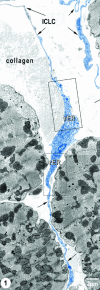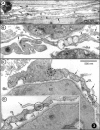A distinct type of cell in myocardium: interstitial Cajal-like cells (ICLCs)
- PMID: 19183408
- PMCID: PMC3823356
- DOI: 10.1111/j.1582-4934.2008.00668.x
A distinct type of cell in myocardium: interstitial Cajal-like cells (ICLCs)
Abstract
The existence of a novel type of interstitial cells in the heart, interstitial Cajal-like cells (ICLCs), had been described for the first time in 2005. Their identification was mainly based on ultrastructural criteria: very long (tens up to hundreds of micrometres) and moniliform prolongations, which are extremely thin (less than 0.2 microm), below the resolving power of light microscopy. Myocardial ICLCs were also identified by methylene-blue vital staining, silver impregnation, and immunoreactivity for CD 34, vimentin, CD117/c-kit, etc. Although a series of studies provided evidence for the existence of ICLCs in human atria and rat ventricles, further investigations in other laboratories, using additional techniques, are required to substantiate the consistency of these findings. Here we provide further evidence for the existence of ICLCs in human and mammalian hearts (by transmission and scanning electron microscopy, as well as confocal laser scanning microscopy). Noteworthy, we confirm that ICLCs communicate with neighbouring cells via shedding (micro)vesicles. Although these so-called ICLCs represent a distinct type of cells, different from classical interstitial cells of Cajal, or fibroblasts, their role(s) in myocardium remain(s) to be established. Several hypotheses are proposed: (i) adult stromal (mesenchymal) stem cells, which might participate in cardiac repair/remodelling; (ii) intercellular signalling (e.g. via shedding microvesicles); (iii) chemo-mechanical transducers and (iv) players in pacemaking and/or arrhytmogenesis, and so on.
Figures









References
-
- Rumessen JJ, Vanderwinden JM. Interstitial cells in the musculature of the gastrointestinal tract: Cajal and beyond. Int Rev Cytol. 2003;229:115–208. - PubMed
-
- Faussone-Pellegrini MS. Interstitial cells of Cajal: once negligible players, now blazing protagonists. Ital J Anat Embryol. 2005;110:11–31. - PubMed
-
- Sanders KM, Koh SD, Ward SM. Interstitial cells of Cajal as pacemakers in the gastrointestinal tract. Annu Rev Physiol. 2006;68:307–43. - PubMed
MeSH terms
Substances
LinkOut - more resources
Full Text Sources

